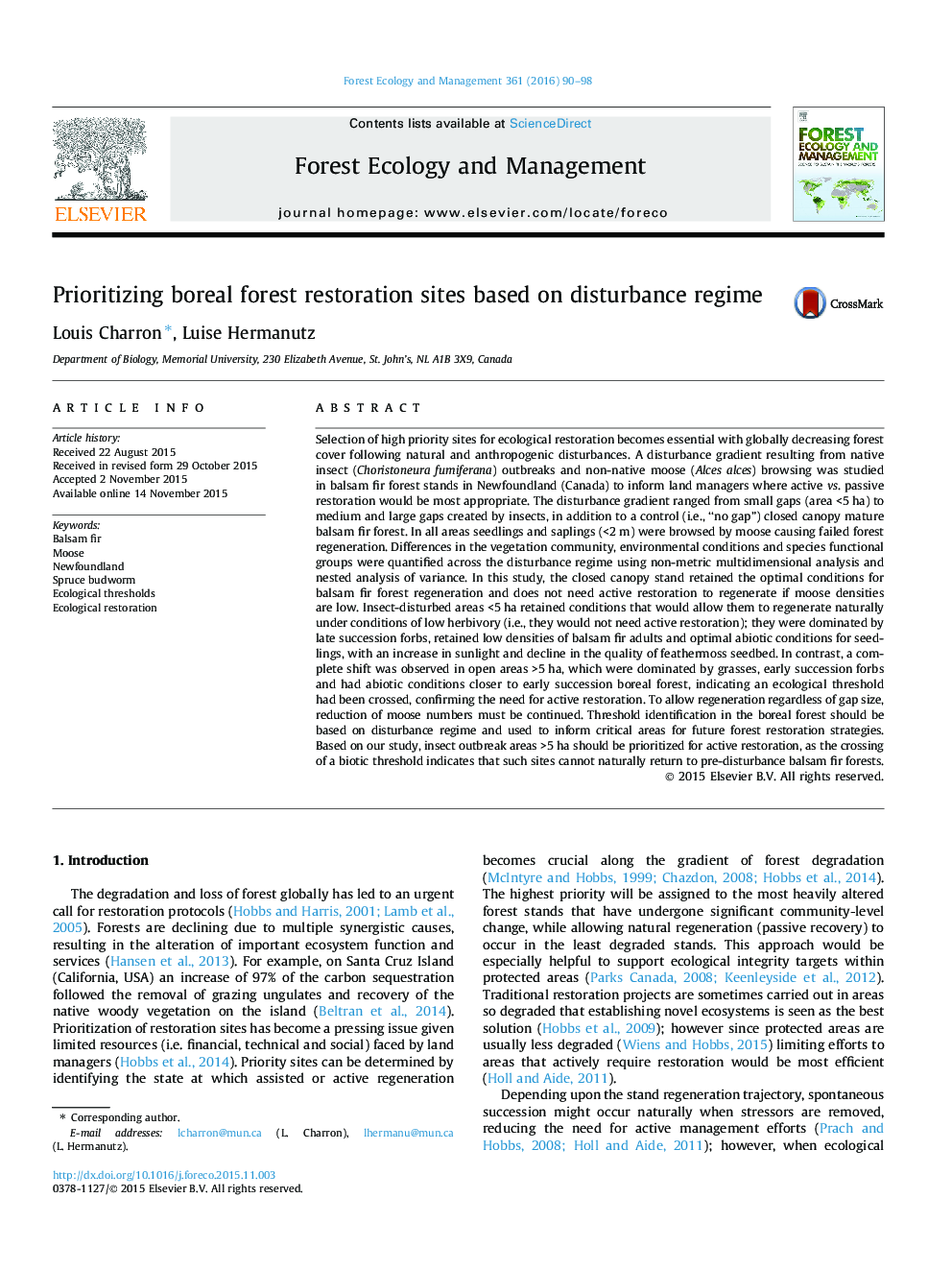| کد مقاله | کد نشریه | سال انتشار | مقاله انگلیسی | نسخه تمام متن |
|---|---|---|---|---|
| 6542428 | 159160 | 2016 | 9 صفحه PDF | دانلود رایگان |
عنوان انگلیسی مقاله ISI
Prioritizing boreal forest restoration sites based on disturbance regime
ترجمه فارسی عنوان
اولویت بندی سایت های بازسازی جنگل های بکر براساس رژیم اختلال
دانلود مقاله + سفارش ترجمه
دانلود مقاله ISI انگلیسی
رایگان برای ایرانیان
کلمات کلیدی
شاهزاده بلسان، گوزن شمالی، نیوفاندلند، صنوبر صنوبر، آستانه های محیطی، بازسازی محیطی،
موضوعات مرتبط
علوم زیستی و بیوفناوری
علوم کشاورزی و بیولوژیک
بوم شناسی، تکامل، رفتار و سامانه شناسی
چکیده انگلیسی
Selection of high priority sites for ecological restoration becomes essential with globally decreasing forest cover following natural and anthropogenic disturbances. A disturbance gradient resulting from native insect (Choristoneura fumiferana) outbreaks and non-native moose (Alces alces) browsing was studied in balsam fir forest stands in Newfoundland (Canada) to inform land managers where active vs. passive restoration would be most appropriate. The disturbance gradient ranged from small gaps (area <5Â ha) to medium and large gaps created by insects, in addition to a control (i.e., “no gap”) closed canopy mature balsam fir forest. In all areas seedlings and saplings (<2Â m) were browsed by moose causing failed forest regeneration. Differences in the vegetation community, environmental conditions and species functional groups were quantified across the disturbance regime using non-metric multidimensional analysis and nested analysis of variance. In this study, the closed canopy stand retained the optimal conditions for balsam fir forest regeneration and does not need active restoration to regenerate if moose densities are low. Insect-disturbed areas <5Â ha retained conditions that would allow them to regenerate naturally under conditions of low herbivory (i.e., they would not need active restoration); they were dominated by late succession forbs, retained low densities of balsam fir adults and optimal abiotic conditions for seedlings, with an increase in sunlight and decline in the quality of feathermoss seedbed. In contrast, a complete shift was observed in open areas >5Â ha, which were dominated by grasses, early succession forbs and had abiotic conditions closer to early succession boreal forest, indicating an ecological threshold had been crossed, confirming the need for active restoration. To allow regeneration regardless of gap size, reduction of moose numbers must be continued. Threshold identification in the boreal forest should be based on disturbance regime and used to inform critical areas for future forest restoration strategies. Based on our study, insect outbreak areas >5Â ha should be prioritized for active restoration, as the crossing of a biotic threshold indicates that such sites cannot naturally return to pre-disturbance balsam fir forests.
ناشر
Database: Elsevier - ScienceDirect (ساینس دایرکت)
Journal: Forest Ecology and Management - Volume 361, 1 February 2016, Pages 90-98
Journal: Forest Ecology and Management - Volume 361, 1 February 2016, Pages 90-98
نویسندگان
Louis Charron, Luise Hermanutz,
